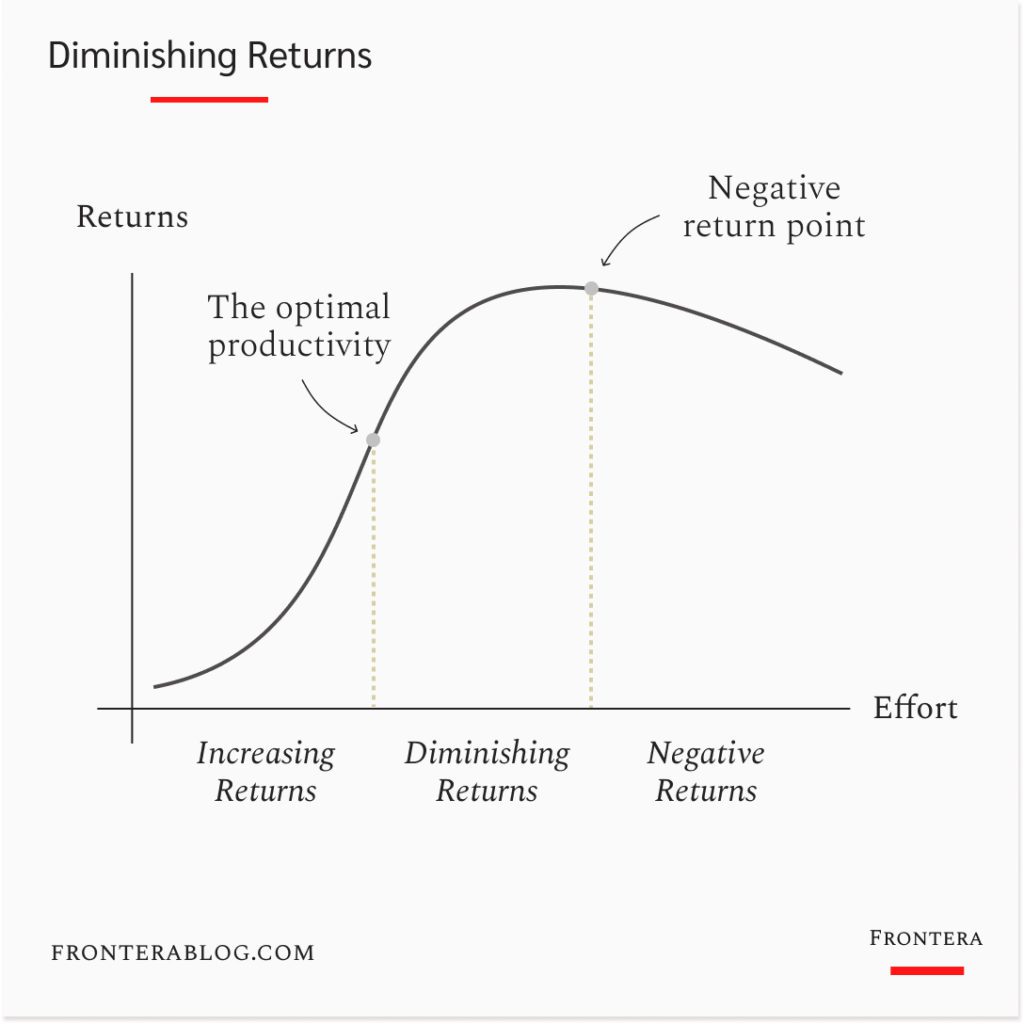What is the law of diminishing returns?
The law of diminishing returns is a concept from economics that indicates after a certain point, increasing only one input starts producing fewer returns.
Let’s see how Henry Ford used it to increase the productivity of Ford workers with fewer working hours. And how you can do the same.
In October 1926, Henry Ford made a big decision.
He announced that Ford was reducing the workdays from six to five.
And with no pay cuts.
The world was surprised.
Why would a business owner want workers to work less?
But it was not Henry Ford’s first unexpected decision.
A decade ago, he doubled salaries overnight to fix the high employee turnover problem.
And it worked.
High salaries allowed Ford to hire and keep the best talent in Detroit’s competitive auto industry.

With the 40-hour workweek plan, he had pragmatic reasons again.
When returns start diminishing
Ford realized workers were physically and mentally exhausted after six days of monotonous work.
Productivity was always low at the end of the week.
Plus, as workers had only Sunday off; they spent the day resting.
They had money.
But no time or energy to consume.
So Ford thought workers would buy more stuff —including cars— if they had more free time.
And they would be more productive at work.
If the idea was not coming from Henry Ford, people would laugh at it.
But he was right again.
His decision became so impactful, other companies (and countries) followed it.
And almost 100 years later, most companies still have a 40-hour workweek today.
Now, what Ford saw was after a certain point, increasing one input —when everything else is constant— starts producing fewer returns.
And it’s called the law of diminishing returns.

Some other examples:
- Perfectionism: After a certain point, working more on a task or project creates less value. I could spend a few more days “perfecting” this article, but the return I’d get from those hours would go lower and lower.
- Analysis paralysis: After you know the essentials, waiting to get more information doesn’t increase the quality of decisions. It wastes time. In his 2016 shareholder letter, Jeff Bezos suggested Amazon employees make decisions when they have around 70% of the information they wish they had.
- Workouts: If you are trying to build muscle, the returns you get from a workout start diminishing after some time. And if you lift weights for three hours like the bodybuilders from the 70s, you reach the negative returns stage.
The problem the law of diminishing returns shows is obvious.
Beyond the optimal point, efficiency drops.
You start wasting resources that would be more useful somewhere else.
So the question is: how can you avoid it?
Three Ways To Avoid Diminishing Returns
1. Find the core
Let’s say you are developing a product.
And you want an exceptional design.
So you allocate all your resources to make it pixel-perfect.
But beyond a point, the return you get from spending more resources on design will start diminishing.
That effort might be better used somewhere else — like marketing.
In the end, a good product with decent marketing will beat a perfect product with no marketing.
Yes, there is nothing wrong with having one main focus. Remember Blitzkrieg.
But you still have to maintain other areas.
What’s the best way to do it?
Identify the core 20% activities that will give 80% of the results in each area of your business (and life).
Do them first.
2. Explore different variables
We’ve talked about how Ford optimized work hours and salaries.
But that was not all.
He was obsessed with efficiency.
He was a system thinker.
To make cars as cheap as possible, he tried to optimize all variables.
The number of workers, machinery, factories…
You can do the same.
When you see you are close to optimal returns with one variable, experiment with others.
One example.
If you have a training program that works well, what would give you more returns:
Trying to make that program perfect?
Or fixing your diet?
The answer is obvious.
3. Change the game
You know the story.
Amazon started with books.
But Bezos knew there were only so many physical books they could sell.
So he expanded to other product lines.
Now imagine what would Amazon be today if they continued to sell only books.
Maybe, they wouldn’t even exist.
Because more effort put into selling books would start diminishing after some time.
So Bezos never allowed that.
He kept changing the game to reset the curve of returns.
Even though they were successful.
It’s counterintuitive to keep inventing when you are already successful.
When most people find something that works well, they stick with it.
They think what works today will work forever.
But returns eventually start diminishing.
So keep adding new layers to the game even when what you do works well.
Never allow victory to defeat you.
–
Enjoyed this article?
Then you’ll love the How Brands Win Newsletter.
Get the “5 Mental Models to Differentiate Your Business” guide when you join. It’s free.
